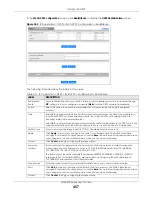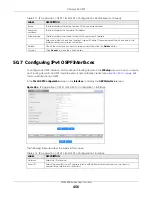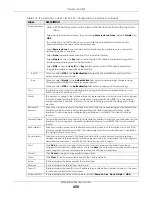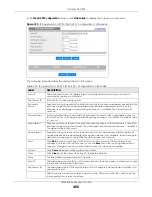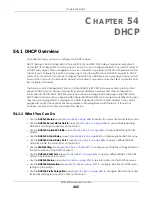
Chapter 51 IGMP
XGS4600 Series User’s Guide
471
The Switch supports IGMP version 1 (
IGMP-v1
), version 2 (
IGMP-v2
)
and IGMP version 3 (
IGMP-v3
). Refer
to RFC 1112, RFC 2236
and RFC 3376 for information on IGMP versions 1, 2 and 3 respectively. At start up,
the Switch queries all directly connected networks to gather group membership. After that, the Switch
periodically updates this information.
51.1.1 How IGMP Works
This section describes how IGMP works and the changes it has gone through from version 1 to version 3.
IGMP version 1 defines how a multicast router checks to see if any multicast hosts are part of a multicast
group. It checks for group membership by sending out an IGMP Query packet. Hosts that are members
of a multicast group reply with an IGMP Report packet. This is also referred to as a join group request. The
multicast router then keeps a list of all networks that have members of this multicast group and forwards
multicast traffic to that network.
Figure 372
IGMP Version 1 Example
The main difference in IGMP version 2 is that it provides a mechanism for a multicast group member to
notify a multicast router that it is leaving a multicast group. The multicast router then sends a group-
specific IGMP query to check if there are any members remaining in that group. If the multicast router
does not receive an IGMP report from any members, it stops sending multicast traffic to that group. This
change helps shorten the leave convergence time, in other words, the amount of time that a multicast
router believes that there are group members on a particular network. This in turn helps reduce the
amount of multicast traffic going through the multicast router.
Figure 373
IGMP Version 2 Example
IGMP version 3 allows a multicast host to join a multicast group and specify from which source (multicast
server) it wants to receive multicast packets. Alternatively, a multicast host can specify from which
multicast servers it does not want to receive multicast packets. In the following figure multicast server
X
(IP address
10.1.1.1
) and multicast server
Z
(IP address
13.2.2.2
) both send multicast traffic to the same
multicast group identified by the multicast IP address
225.1.1.1
. In IGMP version 3 multicast host
A
can
Содержание XGS4600 Series
Страница 24: ...24 PART I User s Guide ...
Страница 44: ...44 PART II Technical Reference ...
Страница 180: ...Chapter 13 Spanning Tree Protocol XGS4600 Series User s Guide 180 Figure 145 MSTP and Legacy RSTP Network Example ...
Страница 189: ...Chapter 16 Mirroring XGS4600 Series User s Guide 189 Figure 150 Advanced Application Mirroring Standalone Mode ...
Страница 244: ...Chapter 22 Policy Rule XGS4600 Series User s Guide 244 Figure 189 Policy Example EXAMPLE ...
Страница 277: ...Chapter 25 Multicast XGS4600 Series User s Guide 277 Figure 215 Advanced Application Multicast MVR Standalone Mode ...
Страница 559: ...Chapter 59 Access Control XGS4600 Series User s Guide 559 Figure 460 Example Lock Denoting a Secure Connection EXAMPLE ...
Страница 586: ...Chapter 69 Configure Clone XGS4600 Series User s Guide 586 Figure 479 Management Configure Clone Standalone Mode ...
Страница 587: ...Chapter 69 Configure Clone XGS4600 Series User s Guide 587 Figure 480 Management Configure Clone Stacking Mode ...
Страница 594: ...Chapter 71 Port Status XGS4600 Series User s Guide 594 Figure 485 Management Port Status Port Details Standalone Mode ...
Страница 604: ...604 PART III Troubleshooting and Appendices ...

